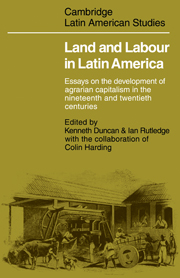 Land and Labour in Latin America
Land and Labour in Latin America Book contents
- Frontmatter
- Contents
- List of tables
- List of figures
- List of maps
- Acknowledgements
- 1 Introduction: patterns of agrarian capitalism in Latin America
- PART I THE TRANSITION FROM TRADITIONAL HACIENDA TO CAPITALIST ESTATE
- 2 Hacienda profits and tenant farming in the Mexican Bajío, 1700–1860
- 3 Landlord, labourer, and tenant in San Luis Potosí, northern Mexico, 1822–1910
- 4 Land and labour in rural Chile, 1850–1935
- 5 The development of the Chilean hacienda system, 1850–1973
- 6 Relations of production in Andean haciendas: Peru
- 7 The formation of the coffee estate in nineteenth-century Costa Rica
- PART II THE DEVELOPMENT OF A PLANTATION ECONOMY WITH LABOUR RECRUITMENT FROM HIGHLAND PEASANT COMMUNITIES
- PART III THE DEVELOPMENT OF COMMERCIAL AGRICULTURE USING EUROPEAN IMMIGRANT LABOUR
- PART IV THE TRANSITION FROM SLAVE PLANTATION TO CAPITALIST PLANTATION
- PART V POSTSCRIPT
- Glossary of Spanish and Portuguese terms used in the text
- Weights and measures
- Notes on contributors
- Indexes Subjects
- Authors
2 - Hacienda profits and tenant farming in the Mexican Bajío, 1700–1860
Published online by Cambridge University Press: 07 May 2010
- Frontmatter
- Contents
- List of tables
- List of figures
- List of maps
- Acknowledgements
- 1 Introduction: patterns of agrarian capitalism in Latin America
- PART I THE TRANSITION FROM TRADITIONAL HACIENDA TO CAPITALIST ESTATE
- 2 Hacienda profits and tenant farming in the Mexican Bajío, 1700–1860
- 3 Landlord, labourer, and tenant in San Luis Potosí, northern Mexico, 1822–1910
- 4 Land and labour in rural Chile, 1850–1935
- 5 The development of the Chilean hacienda system, 1850–1973
- 6 Relations of production in Andean haciendas: Peru
- 7 The formation of the coffee estate in nineteenth-century Costa Rica
- PART II THE DEVELOPMENT OF A PLANTATION ECONOMY WITH LABOUR RECRUITMENT FROM HIGHLAND PEASANT COMMUNITIES
- PART III THE DEVELOPMENT OF COMMERCIAL AGRICULTURE USING EUROPEAN IMMIGRANT LABOUR
- PART IV THE TRANSITION FROM SLAVE PLANTATION TO CAPITALIST PLANTATION
- PART V POSTSCRIPT
- Glossary of Spanish and Portuguese terms used in the text
- Weights and measures
- Notes on contributors
- Indexes Subjects
- Authors
Summary
Introduction: the diversity of the Mexican hacienda
In the common usage of Mexico the term ‘hacienda’ simply meant a large estate. It designated an extensive tract of contiguous land held under single ownership, be it of an individual, a family, or an institution. Usually, it implied the presence of a casco, which included a set of buildings to house the mayordomo (administrator) or the owner, and corrals for livestock or barns for grain. It suggested some degree of formal exploitation of the territory in question, either for pasture or for cultivation. The term offered little guide to physical extension. In the Bajío it was customary to restrict its application to properties which at least encompassed a sitio de estancia de ganado menor, that is to say, 18 caballerías or about 780 hectares. Many estates, especially in the arid north, were much larger; the Tetillas in Zacatecas covered no less than 200,000 hectares. By contrast, in Tlaxcala mere farms were at times called haciendas Similarly, the term embraced all types of agricultural activity. A hacienda could be a sugar plantation, a ranch for cattle and sheep, or a farm which grew cereals, regardless of the fact that each class of enterprise differed markedly in its deployment of labour, capital, and land. To compound the problem of definition, a hacienda did not necessarily constitute a single unit of production; in many districts landowners rented a considerable portion of their land to tenant farmers. In this diversity the Mexican large estate resembled its medieval counterpart, of which Georges Duby wrote that ‘The destiny of every manor was individual and its structure unique’.
- Type
- Chapter
- Information
- Land and Labour in Latin AmericaEssays on the Development of Agrarian Capitalism in the nineteenth and twentieth centuries, pp. 23 - 58Publisher: Cambridge University PressPrint publication year: 1978
- 2
- Cited by


